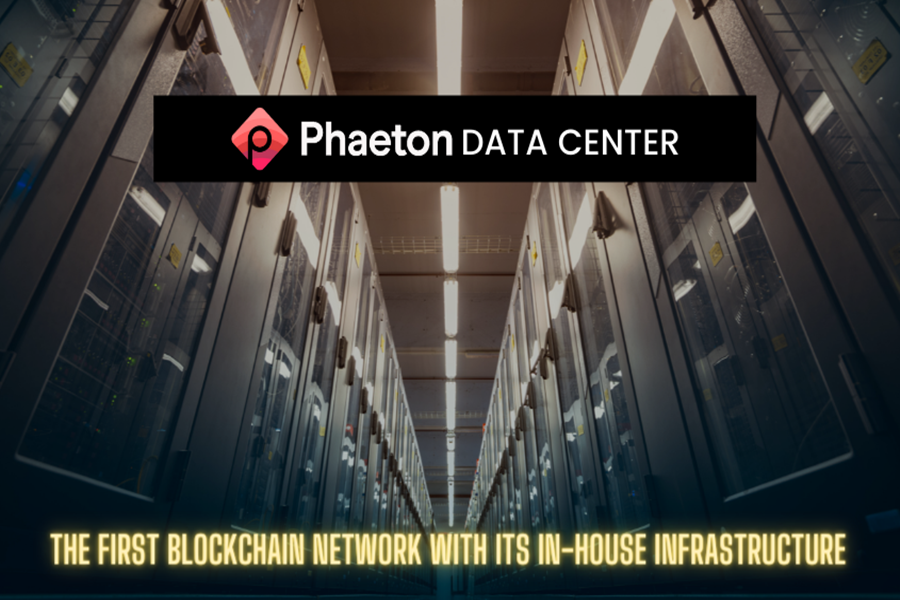The foundation of every robust Blockchain Platform is datacenters. These centers are where the servers, data and algorithms are kept for operating, storing and supervising a Blockchain platform. For these datacenters to perform smoothly, significant electrical energy is required to run the servers, which require mechanisms for cooling. Therefore, the power consumption of Blockchain datacenters is exceptionally high. Unfortunately, present datacenters are powered by fossil fuel sources, which contribute to carbon emissions.
It is interesting to note that the Datacenter Services Market capitalization was valued at USD48.90 billion in 2020, with a projected growth to USD105.60 billion by 2026, experiencing a compounded annual growth rate of 13.69% between 2021-2026. Thus, it is a lucrative market, but unfortunately, many datacenters do not address their effect on climate change.
As Blockchain platforms store significant amounts of data, Phaeton is building and owning its own data centers. It is the first Blockchain platform to develop its own infrastructure. Most other Blockchains rely on datacenters owned and operated by large corporations such as Microsoft, Google and Amazon. Furthermore, these datacenters consume significant terawatt-hours, contributing a 2% consumption of global fossil fuel-generated electricity. This consumption is projected to rise to 20% by the middle of the next decade.
In their whitepaper, Phaeton state that they put people and the environment before profit. In line with their Social Impact ethos and ESG principles, Phaeton is powering its datacenters with renewable energy. These renewable sources include solar, geothermal, hydrogen and wind. Currently, Phaeton is in the final stages of constructing an Off-Grid Modular Datacenters projected to be displayed by January 2022. In addition, plans are already concluded to include datacenters in two properties that will start construction in the first quarter of 2022. In addition, datacenters are to be deployed into the construction of ten (10) Community Grid Solar Farms.
From an investor’s perspective, Phaeton’s strategy is to build, own, and operate its own data centers, increasing its asset value over time. In addition, this strategy will provide a firm backing for their native token (PHAE), which directly benefits all stakeholders (shares and coins).
The Need For Phaeton to Build Its Own Data Centers
Phaeton is dedicated to ensuring zero carbon emissions by running its hardware on power generation that does not come from fossil fuels. They realized that they had no control over the power consumption of already established corporate datacenters. They then decided to build and control their own datacenters using renewable energy.
In addition, Phaeton needs to secure as many decentralized nodes as possible to improve transaction speed on the network. By owning data centers, Phaeton will have better control to secure and manage these nodes. As the decentralized node locations increase and expand, security improves, and thus the network becomes less prone to hacking. In addition, data is replicated from one datacenter to another, ensuring that data cannot be lost should one data center fail. It also helps data recovery to re-initialize a data center in the case of any unforeseen problem.
Phaeton and Its Various Data Centers
Phaeton datacenters are modular in design. It, therefore, allows flexibility and scalability. Developed with a negative pressure cooling system, Phaeton datacenters are optimized for efficient power consumption and accelerated operational processes to increase transaction speed. The two types of Phaeton’s datacenters are outlined below.
- Off-Grid Modular Datacenters (OMD): OMDs are designed within a 20ft container. These datacenters are solar wrapped intended for operations in remote and regional locations. The datacenters are secured with both physical biometrics and an advanced network security protocol. The network is managed and monitored remotely. With their modular design and mobility, OMDs can be located anywhere, from remote mine sites to desert areas or the rooftop of high-rise buildings.
- The Community Datacenters: Phaeton’s first stage development plan includes deploying ten (10) community Micro-Grid solar farms. Along with these farms, Phaeton will include the construction of ten (10) Modular community data centers, one data center per farm. The community datacenters will vary in scale in line with the demand of the surrounding communities.
Phaeton is committed to providing Blockchain solutions without contributing any negative impact to the environment. This goal had led to the development of renewable energy powered data centers through strategic partnerships in power & energy, construction, and power electronics. The development and operation of these data centres help run the Phaeton Blockchain and its associated products efficiently, effectively, and safely. The datacenters also add value to Phaeton’s Real Estate portfolio as the land and building will be owned by Phaeton. In addition, these and other business-oriented solutions will help sustain the high value of their native PHAE token and ensure maximum return for their shareholders.
To learn more about Phaeton, visit Phaeton.io.
Phaeton IEO on latoken: https://latoken.com/ieo/PHAE
Phaeton IEO on p2pb2b: https://p2pb2b.io/token-sale/316
Telegram: http://bit.ly/Phaeton_telegram
